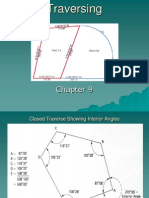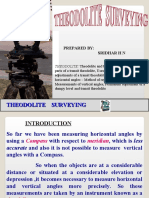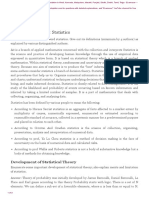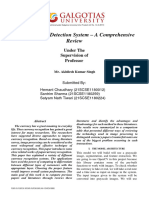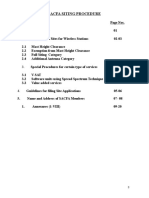Levelling
Levelling
Uploaded by
etikafCopyright:
Available Formats
Levelling
Levelling
Uploaded by
etikafCopyright
Available Formats
Share this document
Did you find this document useful?
Is this content inappropriate?
Copyright:
Available Formats
Levelling
Levelling
Uploaded by
etikafCopyright:
Available Formats
Handout # 3
Course Instructor: Etikaf Hussain Batch: 2011-12, FE Civil/ Construction
LEVELLING
1. INTRODUCTION: Levelling is the general term applied to any of the various processes by which elevations of points or differences in elevation are determined. It is a vital operation in producing necessary data for mapping, engineering design, and construction. Levelling results are used to: i. design highways, railroads, canals, sewers, water supply systems, and other facilities having grade lines that best conform to existing topography; ii. lay out construction projects according to planned elevations; iii. calculate volumes of earthwork and other materials; iv. investigate drainage characteristics of an area; v. develop maps showing general ground configurations; vi. Study earth subsidence and crustal motion. 2. BASIC DEFINITIONS: Basic terms in levelling are defined here, some of which are illustrated in Figure 1. 2.1 Vertical line: A line that follows the local direction of gravity as indicated by a plumb line. 2.2 Level surface: A curved surface that at every point is perpendicular to the local plumb line (the direction in which gravity acts). Level surfaces are approximately spheroidal in shape. A body of still water is the closest example of a level surface. 2.3 Level line: A line in a level surfacetherefore, a curved line. 2.4 Horizontal plane: A plane perpendicular to the local direction of gravity. In plane surveying, it is a plane perpendicular to the local vertical line. 2.5 Horizontal line: A line in a horizontal plane. In plane surveying, it is a line perpendicular to the local vertical. 2.6 Datum: A datum is any reference surface to which the elevations of points are referred. The most commonly used datum is that of mean sea level (MSL). 2.7 Elevation: An elevation is a vertical distance above or below a reference datum. In surveying, the reference datum that is universally employed is mean sea level (MSL).
Fig. 1 Levelling concept Page 1 of 11
Handout # 3
LEVELLING
FE CIVIL / CONSTRUCTION (2011-12)
2.8 Bench mark: In surveying bench mark is a point of known elevation. In general it is a point whose all dimensions (x, y, z) are known. 2.9 Back sight (B.S): It is the first sight taken after the setting up of the instrument. Initially it is usually made to some form of bench mark. 2.10 Fore sight (F.S): It is the last sight taken before moving the instrument. 2.11 Intermediate sight (I.S): It is any other sight taken except back sight and fore sight. 2.12 Height of instrument (H.I): It is the elevation of the line of sight through the level. 3. CLASSIFICATION OF LEVELLING: 3.1 Differential levelling: Differential levelling is used to determine differences in elevation between points (that are some distance from each other) by using a surveyors level and a graduated measuring rod. 3.2 Profile levelling: It is the operation in which the object is to determine the elevation of points at known distances apart along a given line so as to obtain accurate outline of the surface of the ground. This is also known is as longitudinal levelling. 3.3 Reciprocal levelling: It is the method of levelling in which the difference in elevation between two points is accurately determined by two sets of observations, when it is not possible to set up the level midway between two points. 3.4 Trigonometric levelling: It is the process of levelling in which the elevations of points are computed from the vertical angle and horizontal or slope distance measured in the field. 3.5 Bench mark levelling: BM levelling is the type of levelling employed when a system of BMs is to be established or when an existing system of BMs is to be extended or densified. Perhaps a BM is required in a new location, or perhaps an existing BM has been destroyed and a suitable replacement is required. BM levelling is typified by the relatively high level of precision specified, both for the instrumentation and for the technique itself. It is also known as vertical control surveys 3.5 Barometric levelling: This method depends on the principle that atmospheric pressure depends upon the elevation of place. Barometer is used to measure the atmospheric pressure and hence elevation is computed. However it is not accurate method since the atmospheric pressure depends upon season and temperature also. It may be used in exploratory surveys. 3.6 Hypsometry: This is based on the principle that boiling point of water decreases with the elevation of the place. Hence the elevation difference between two points may be found by noting the difference in boiling point of water in the two places. This method is also useful only for exploratory survey. 4. THEORY OF DIFFERENTIAL LEVELLING: In this most commonly employed method, a surveyors level is used to read graduated rods held on fixed points. The surveyors level consists of a cross hairequipped telescope and an attached spirit level, both of which are mounted on a sturdy tripod. The surveyor can sight through the levelled telescope to a rod graduated in feet or meters and determine a measurement reading at the point where the cross hair intersects the rod. Page 2 of 11
Handout # 3
LEVELLING
FE CIVIL / CONSTRUCTION (2011-12)
The basic procedure is illustrated in Figure 2. An instrument is set up between BM Rock and point X. Assume the elevation of BM Rock is known to be 820.00 ft. After levelling the instrument, a back sight taken on a rod held on the BM gives a reading of 8.42 ft. The B.S is used to compute the height of instrument (HI), Direction of the sightwhether forward, backward, or sidewaysis not important. Adding the B.S 8.42 ft to the elevation of BM Rock, 820.00, gives an HI of 828.42 ft. If the telescope is then turned to bring into view a rod held on point X a foresight (FS) is obtained. In this example, it is 1.20 ft. Subtracting the F.S 1.20 ft, from the HI, 828.42 ft, gives the elevation of point X as 827.22 ft.
Fig. 2 Basic concept of differential levelling Differential levelling theory and applications can thus be expressed by two equations, which are repeated over and over: HI = RLBM + BS RLX = HI X Where, HI = Height of Instrument RLBM = Reduced level (elevation) of Bench Mark BS = Back Sight RLX = Reduced level of any point X X = Staff reading at point X (Can be a Fore Sight FS or Intermediate Sight IS) 4.1 Calculations of reduced level using Height of Instrument (HI) method: In reducing the levels for various points by the height of instrument method, the height of instrument (H.I.) for the each section highlighted by different shade is determined by adding the elevation of the point to the back sight reading taken at that point. The H.I. remains unchanged for all the staff readings taken within that section and therefore, the levels of all the points lying in that section are reduced by subtracting the corresponding staff readings, i.e., I.S. or F.S., from the H.I. of that section. Page 3 of 11
Handout # 3
LEVELLING
FE CIVIL / CONSTRUCTION (2011-12)
Arithmetic check: The arithmetic involved in reduction of the levels is used as check on the computations. The following rules are used in the HI method of reduction of levels. B.S. F.S. = Last R.L. First R.L. Q1: Find the elevations at all points using HI method. Also apply arithmetic check. Station BS (ft) IS (ft) FS (ft) HI RL (ft) Remarks A 4.20 100.00 4.30 B 4.33 4.36 4.32 4.25 C 4.22 4.93 4.24 (See lecture notes for solution) 4.2 Calculations of reduced level using Rise and fall method: In the rise and fall method, the rises and the falls are found out for the points lying within each section. Adding or subtracting the rise or fall to or from the reduced level of the backward station obtains the level for a forward station. In Table below, r and f indicate the rise and the fall, respectively, assumed between the consecutive points.
Page 4 of 11
Handout # 3
LEVELLING
FE CIVIL / CONSTRUCTION (2011-12)
Arithmetic check: The arithmetic involved in reduction of the levels is used as check on the computations. The following rules are used in the Rise & Fall method of reduction of levels. B.S. F.S. = Rise Fall = Last R.L. First R.L.
Q2: Find the elevations at all points using rise and fall method. Also apply arithmetic check. Station BS (ft) IS (ft) FS (ft) Rise Fall RL (ft) Remarks A 4.20 100.00 4.30 B 4.33 4.36 4.32 4.25 C 4.22 4.93 4.24 (See lecture notes for solution)
Q3: The following consecutive readings were taken using an automatic level. The terrain was such that the surveyor had to shift the instrument after 4th and 8th sight. The first sight was taken at a BM having reduced level of 100m. The sights were: 0.894, 1.643, 2.896, 3.016, 0.954, 0.692, 0.582, 0.251, 0.996, 2.135 Calculate RL of each point using HI method & rise and fall method and perform necessary check. (See lecture notes for solution) 4.3 Effect of curvature and refraction in levelling: From the definitions of a level surface and a horizontal line, it is evident that the horizontal plane departs from a level surface because of curvature of the Earth. In Figure 3(a), the deviation DB from a horizontal line through point A is expressed approximately by the formulae:
Where, the departure of a level surface from a horizontal line is in feet or in meters, M is the distance AB in miles, F is the distance in thousands of feet, and K is the distance in kilometres.
Fig. 3(a) Curvature and refraction
Fig. 3(b) Refraction
Since points A and B are on a level line, they have the same elevation. If a graduated rod was held vertically at B and a reading was taken on it by means of a telescope with its line of sight AD horizontal, the Earths curvature would cause the reading to be read too high by length BD. Page 5 of 11
Handout # 3
LEVELLING
FE CIVIL / CONSTRUCTION (2011-12)
Light rays passing through the Earths atmosphere are bent or refracted toward the Earths surface, as shown in Figure 3(b). Thus a theoretically horizontal line of sight, like AH in Figure 3(a), is bent to the curved form AR. Hence, the reading on a rod held at R is diminished by length RH. Displacement resulting from refraction is variable. It depends on atmospheric conditions, length of line, and the angle a sight line makes with the vertical. For a horizontal sight, refraction Rf in feet or Rm in meters is expressed approximately by the formulae:
This is about one seventh the effect of curvature of the Earth, but in the opposite direction. The combined effect of curvature and refraction, h in Figure 3(a), is approximately:
Where, hf is in feet, and hm is in metre. Q4: Find the reduced level of all points given that; Station Distance(m) BS IS FS HI (m) (m) (m) A 0.894 600 1.643 1200 2.896 B 1800 0.954 3.016 600 0.692 1200 0.585 C 1800 1.552 0.251 600 0.996 1200 2.135 (See lecture notes for solution) RL 100.000 CorrecTion RLcorrected Remarks BM
5. TRIGNOMETRIC LEVELLING: The difference in elevation between two points can be determined by measuring (1) the inclined or horizontal distance between them and (2) the zenith angle or the altitude angle to one point from the other. (Zenith and altitude angles are measured in vertical planes. Zenith angles are observed downward from vertical, and altitude angles are observed up or down from horizontal.) Thus, in Figure 4, if slope distance S and zenith angle Z or altitude angle between C and D are observed, then V, the elevation difference between C and D, is; V = S x Cos z OR V = S x Sin
Page 6 of 11
Handout # 3
LEVELLING
FE CIVIL / CONSTRUCTION (2011-12)
Fig. 4 Trigonometric levelling Alternatively, if horizontal distance H between C and D is measured, then V is; V = H x Cot z OR V = H x tan
The difference in elevation ( elev) between points A and B in Figure 4 is given by; elev. = hi + V- r Q5: If the zenith angle measured is 42, slope distance measured is 275.62ft to point D, height of instrument is 3.45ft from point A, staff reading is 1.26ft. What is the difference of elevation between point A and B? (See lecture notes for solution) 6. RECIPROCAL LEVELLING: Sometimes in levelling across topographic features such as rivers, lakes, and canyons, it is difficult or impossible to keep fore and back sights short and equal. Reciprocal levelling may be utilized at such locations. As shown in Figure 5, a level is set up on one side of a river at X, near A, and rod readings are taken on points A and B. Since XB is very long, several readings are taken for averaging. Reading, turning the levelling screws to throw the instrument out of level, re-levelling, and reading again, does this. The process is repeated two, three, four, or more times. Then the instrument is moved close to Y and the same procedure followed. The two differences in elevation between A and B, determined with an instrument first at X and then at Y, will not agree normally because of curvature, refraction, and personal and instrumental errors. However, in the procedure just outlined, the long fore-sight from X to B is balanced by the long back-sight from Y to A. Thus the average of the two elevation differences cancels the effects of curvature, refraction, and instrumental errors, so the result is accepted as the correct value if the precision of the two differences appears satisfactory. Delays at X and Y should be minimized because refraction varies with changing atmospheric conditions. Page 7 of 11
Handout # 3
LEVELLING
FE CIVIL / CONSTRUCTION (2011-12)
If the two points between which the difference of level is required to be determined are A and B then in reciprocal levelling, the first set of staff readings (a1 and b1) is taken by placing the staff on A and B, and instrument at X. The second set of readings (a2 and b2) is taken again on A and B by placing the instrument at Y. The difference of level between A and B is given by: ( ) ( )
Fig. 5 Reciprocal levelling and the combine error is given by: ( ) ( )
Where, e = Combined error due to collimation, earths curvature and atmospheric refraction Q6: While conducting reciprocal survey, following readings were obtained between A and B: Instrument at X Y Staff reading on A B 1.486 1.725 1.190 1.415
If the reduced level of B is 55.18 m above the datum, what is the reduced level of A? (See lecture notes for solution) Q7 : Reciprocal leveling gives the following readings in meters from a set up near A: on A, 2.558; on B, 1.883, 1.886, and 1.885. At the setup near B: on B, 1.555; on A, 2.228, 2.226, and 2.229. The elevation of A is 158.618 m? (See lecture notes for solution) Page 8 of 11
Handout # 3
LEVELLING
FE CIVIL / CONSTRUCTION (2011-12)
7. PROFILE LEVELLING: The profile of the route is a side view or elevation. Before engineers can properly design linear facilities such as highways, railroads, transmission lines, aqueducts, canals, sewers, and water mains, they need accurate information about the topography along the proposed routes. Profile levelling, which yields elevations at definite points along a reference line, provides the needed data. Profile levelling is same as differential levelling but here the distance is also considered. Elevations are computed at distance interval of 20, 30 or 40 m or wherever sudden change of slope occurs. When these elevations are plotted, a profile of that area is generated. Figure 6 shows the typical profile levelling.
Fig. 6 Example of profile levelling Q8: Find the reduced level of all survey points, given in table below. Also find the slope between first and last sight. (This is a practice problem) Station Chainage BS IS FS HI (m) RL (m) Remarks A 2.868 164.141 161.273 BM 460 0+00 2.060 0+06 1.170 0+20 1.630 0+40 1.620 0+60 1.410 0+80 1.010 B 0+90 1.977 0.982 TP1 1+00 1.730 1+20 1.700 1+30 1.890 1+40 1.670 1+60 1.600 1+80 1.310 1+91 1.930 2+00 0.640 2+15 0.540 Page 9 of 11
Handout # 3
LEVELLING
FE CIVIL / CONSTRUCTION (2011-12)
(See lecture notes for solution) 8. CONTOURS: Contours are lines drawn on a plan that connect points having the same elevation. The vertical distance between contour lines is called the contour interval. Depending on the accuracy required, they may be plotted at 0.1-m to 0.5-m intervals in flat terrain and 1-m to 10-m intervals in undulating terrain. The interval chosen depends on: (1) The type of project involved; (2) The type of terrain, flat or undulating (3) The cost, for the smaller the interval the greater the amount of field data required, resulting in greater expense. 8.1 Characteristics of contours: Although each contour line in nature has a unique shape, all contours adhere to a set of general characteristics. Important ones, fundamental to their proper field location and correct plotting, are listed. 1. Contour lines must close on themselves, either on or off a map. They cannot dead end. 2. Contours are perpendicular to the direction of maximum slope. 3. The slope between adjacent contour lines is assumed to be uniform. (Thus, it is necessary that breaks (changes) in grade be located in topographic surveys.) 4. The distance between contours indicates the steepness of a slope. Wide separation denotes gentle slopes; close spacing, steep slopes; even and parallel spacing, uniform slope. 5. Irregular contours signify rough, rugged country. Smooth lines imply more uniformly rolling terrain. 6. Concentric closed contours that increase in elevation represent hills. A contour forming a closed loop around lower ground is called a depression contour (Spot elevations and hachures inside the lowest contour and pointing to the bottom of a hole or sink with no outlet make map reading easier.) 7. Contours of different elevations never meet except on a vertical surface such as a wall, cliff, or natural bridge. They cross only in the rare case of a cave or overhanging shelf. Knifeedge conditions are never found in natural formations. 8. A contour cannot branch into two contours of the same elevation. 9. Contour lines crossing a stream point upstream and form Vs; they point down the ridge and form Us when crossing a ridge crest. 10. Contour lines go in pairs up valleys and along the sides of ridge tops. 11. Cuts and fills for earth dams, levees, highways, railroads, canals, etc., produce straight or geometrically curved contour lines with uniform, or uniformly graduated spacing. Contours cross sloping or crowned streets in typical V- or U-shaped lines. 8.2 Uses of contours: Contour maps are very useful since they provide valuable information about the terrain. Some of the uses are as follows: (1) Construct longitudinal sections and cross-sections for initial investigation. (2) Compute volumes. (3) Construct route lines of constant gradient. (4) Delineate the limits of constructed dams, road, railways, tunnels, etc. (5) Delineate and measure drainage areas. 8.3 Locating contours: There are two methods of locating contours; 8.3.1 Direct method: In the direct method, the contour to be plotted is actually traced on the ground. Points which happen to fall on a desired contour are only surveyed, plotted and finally joined to obtain the particular contour. This method is slow and tedious and thus used for large scale maps, small contour interval and at high degree of precision. Page 10 of 11
Handout # 3
LEVELLING
FE CIVIL / CONSTRUCTION (2011-12)
8.3.2 Indirect method: In this method, the spot levels of selected guide points are taken with a level and their reduced levels are computed. The horizontal positions of these points are measured or computed and the points are plotted on the plan. The contours are then drawn by a process called interpolation of contours from the levels of the guide points. The following are the indirect methods that are commonly used for locating contours; a. Grid method b. Radial line method c. Tacheometric method
Page 11 of 11
You might also like
- Setting Out ProjectDocument22 pagesSetting Out ProjectAlif AbdullahNo ratings yet
- Nissan Check Engine Light Codes & ECU ResetDocument29 pagesNissan Check Engine Light Codes & ECU ResetMu Netsi0% (2)
- Creep Failure of HP Modified Reformer TubeDocument20 pagesCreep Failure of HP Modified Reformer Tubearaujo angel100% (1)
- Surveying Assignment For BCASDocument13 pagesSurveying Assignment For BCASKrishna Eela0% (1)
- CHAPTER 4 - Levelling DetailDocument17 pagesCHAPTER 4 - Levelling DetailNurisz IskandarNo ratings yet
- Lab Report 1 LevellingDocument7 pagesLab Report 1 Levellingalyaazalikhah78100% (1)
- Levelling in SurveyingDocument20 pagesLevelling in SurveyingMuh UmaNo ratings yet
- C2005 Traverse SurveyDocument11 pagesC2005 Traverse SurveyhjwNo ratings yet
- Levelling PDFDocument21 pagesLevelling PDFRahul Sinha100% (3)
- Levelling Mr. Vedprakash Maralapalle, Asst. Professor Department: B.E. Civil Engineering Subject: Surveying-I Semester: IIIDocument52 pagesLevelling Mr. Vedprakash Maralapalle, Asst. Professor Department: B.E. Civil Engineering Subject: Surveying-I Semester: IIIshivaji_sarvadeNo ratings yet
- SURVEYINGDocument7 pagesSURVEYINGFrannie BorrasNo ratings yet
- Maths NotesDocument71 pagesMaths NotesSekar DineshNo ratings yet
- Levelling and SurveyingDocument7 pagesLevelling and Surveyinghazmee100% (5)
- Levelling IntroductionDocument44 pagesLevelling IntroductionVamsi Krishna33% (3)
- Surveying I Lab ManualDocument33 pagesSurveying I Lab ManualRishabh RajNo ratings yet
- Volume CalculationsDocument11 pagesVolume CalculationsAhmad KhaledNo ratings yet
- Offset From Tangent Line: 1) ObjectivesDocument3 pagesOffset From Tangent Line: 1) ObjectivesZatil FauzaniNo ratings yet
- Theodolite Traversing, Purpose and Principles of Theodolite TraversingDocument15 pagesTheodolite Traversing, Purpose and Principles of Theodolite Traversingsiyamsanker100% (1)
- Control Networks As A Basis For Mapping 1. Horizontal Control NetworksDocument7 pagesControl Networks As A Basis For Mapping 1. Horizontal Control NetworksGathuita Leon100% (1)
- Unit 2 Chain SurveyingDocument35 pagesUnit 2 Chain SurveyingShanmuga PriyanNo ratings yet
- SurveyingDocument63 pagesSurveyingShazrin Yusof100% (1)
- Coordinate System and TraversDocument25 pagesCoordinate System and TraversAhmad Khaled100% (1)
- Compass Traversing: Sharfan UpaulDocument40 pagesCompass Traversing: Sharfan UpaulSumaira Majeed 09No ratings yet
- Chapter 1 CurvesDocument47 pagesChapter 1 Curvesaduyekirkosu1scribdNo ratings yet
- 3 Levelling and ApplicationsDocument32 pages3 Levelling and ApplicationsSathiyaseelan Rengaraju50% (2)
- Chain Surveying: Its Procedure, Instruments, and PrinciplesDocument9 pagesChain Surveying: Its Procedure, Instruments, and PrinciplesB.Satpathy100% (1)
- TraversingDocument8 pagesTraversingsuwashNo ratings yet
- Profile LevelingDocument13 pagesProfile LevelingMarc Dared CagaoanNo ratings yet
- Surveying and Leveling-1Document45 pagesSurveying and Leveling-1anas tariqNo ratings yet
- Module 14-Area ComputationsDocument5 pagesModule 14-Area ComputationsGerovic Parinas50% (2)
- Handout # 4 Traverse Surveying Ce103 2017Document6 pagesHandout # 4 Traverse Surveying Ce103 2017waleed shahidNo ratings yet
- CE6413 Survey Practical II Lab Manual PDFDocument41 pagesCE6413 Survey Practical II Lab Manual PDFAbdur ARNo ratings yet
- Levelling IntroductionDocument43 pagesLevelling IntroductionRohit SainiNo ratings yet
- Survey Unit 1Document46 pagesSurvey Unit 1Swati ChaudharyNo ratings yet
- Chapter 2 Trigonometric HeightingDocument22 pagesChapter 2 Trigonometric HeightingMuhdFikriNo ratings yet
- Handout - TRAVERSE SURVEYINGDocument14 pagesHandout - TRAVERSE SURVEYINGCCCCCCCNo ratings yet
- Chapter 5 - CurvesDocument24 pagesChapter 5 - CurvesHassan YousifNo ratings yet
- Levelling PPT 1Document14 pagesLevelling PPT 1Nandini Anand100% (1)
- M5-1 CE 2131 Open Traverse V21Document20 pagesM5-1 CE 2131 Open Traverse V21Kiziahlyn Fiona BibayNo ratings yet
- Map Projection QuestionsDocument3 pagesMap Projection QuestionsP SCRIBD D scribdNo ratings yet
- Project Report: Profile Levelling & Cross-Sectioning.: Surveying & GeomaticsDocument7 pagesProject Report: Profile Levelling & Cross-Sectioning.: Surveying & Geomaticsdeva mandavgadeNo ratings yet
- Chain Corrections - NotesDocument7 pagesChain Corrections - Notesprakash0% (2)
- Surveying Lab ManualDocument33 pagesSurveying Lab Manualhima sagarNo ratings yet
- 24 Mass Diagram Surveying ManualDocument3 pages24 Mass Diagram Surveying ManualNesya Laxmitha100% (1)
- Fundamentals of Surveying: E.G. EscondoDocument11 pagesFundamentals of Surveying: E.G. EscondoJohn Andrei PorrasNo ratings yet
- TraversingDocument27 pagesTraversingUsha AucharazNo ratings yet
- Laboratory Manual (CIV 210) Engineering Surveying (2018-19) (For Private Circulation Only)Document76 pagesLaboratory Manual (CIV 210) Engineering Surveying (2018-19) (For Private Circulation Only)gyanendraNo ratings yet
- Advanced Engineering Survey: by Engr. Waqas HaroonDocument67 pagesAdvanced Engineering Survey: by Engr. Waqas HaroonWaqas HaroonNo ratings yet
- DBT123 Chapter 3 - Traverse SurveyDocument110 pagesDBT123 Chapter 3 - Traverse Surveyiisya6232No ratings yet
- Surveying With GPS, TS, TlsDocument55 pagesSurveying With GPS, TS, TlsYurio WindiatmokoNo ratings yet
- Elements of Survey and LevelingDocument28 pagesElements of Survey and Levelingvishal4644No ratings yet
- SurveyingDocument84 pagesSurveyingDevanshu JohriNo ratings yet
- Quiz 1Document4 pagesQuiz 1Sherika CoNo ratings yet
- Surveying & GeomaticsDocument14 pagesSurveying & GeomaticsRenjith S Anand0% (1)
- Theodolite SurveyingDocument61 pagesTheodolite SurveyingGagan SNo ratings yet
- Photogrammetric SurveyingDocument22 pagesPhotogrammetric Surveyingcr7 lm10No ratings yet
- Setting Out of A BuildingDocument6 pagesSetting Out of A BuildingKavinda Deshan100% (1)
- SurveyingDocument31 pagesSurveyingPiyush Bhandari100% (1)
- Professional Surveyors and Real Property Descriptions: Composition, Construction, and ComprehensionFrom EverandProfessional Surveyors and Real Property Descriptions: Composition, Construction, and ComprehensionNo ratings yet
- Levelling (Civil, Const and Electrical)Document11 pagesLevelling (Civil, Const and Electrical)hok94645No ratings yet
- LEVELLINGDocument11 pagesLEVELLINGmuhammadsaimsheikh728No ratings yet
- Levelling Lecture Notes 1Document12 pagesLevelling Lecture Notes 1Dennis GichuruNo ratings yet
- Audiovisual TouringBrochure SLAMLexDocument44 pagesAudiovisual TouringBrochure SLAMLexantonioNo ratings yet
- Abhijit Dhar - CV1Document2 pagesAbhijit Dhar - CV1Abhijit PhoenixNo ratings yet
- Observation Task 6Document5 pagesObservation Task 6api-335617097No ratings yet
- Adobe Scan 01 Aug 2023Document1 pageAdobe Scan 01 Aug 2023nbn8785No ratings yet
- AXA PARENTERAL LIMITED - BrochureDocument6 pagesAXA PARENTERAL LIMITED - BrochureRajneesh VermaNo ratings yet
- Samantha CassarDocument1 pageSamantha Cassarapi-506346106No ratings yet
- JurisprudenceDocument13 pagesJurisprudencen9821531759No ratings yet
- GP Drug List Full-130505Document14 pagesGP Drug List Full-130505zilott90No ratings yet
- XRD 6000Document24 pagesXRD 6000Harrisson David Assis SantosNo ratings yet
- Cocoheal Detailed Scientific SummaryDocument11 pagesCocoheal Detailed Scientific Summarymeenatchi sunndharNo ratings yet
- CHM012.1 GEMINA - Activity 1Document2 pagesCHM012.1 GEMINA - Activity 1benjiemel29No ratings yet
- Pre Cal 1st Semester (Midterm) - ReviewerDocument5 pagesPre Cal 1st Semester (Midterm) - ReviewerFrancine Chalcy CanlasNo ratings yet
- STD 11 Biology Maharashtra BoardDocument25 pagesSTD 11 Biology Maharashtra Boarddvya_nair51270% (1)
- RegressionDocument2 pagesRegressionAnand KumarNo ratings yet
- Unit1 Anh (LT)Document9 pagesUnit1 Anh (LT)Yến HảiNo ratings yet
- Wind Turbine Control With Multiple Model Predictive ControlDocument6 pagesWind Turbine Control With Multiple Model Predictive ControlAngelo Sanchez IafantiNo ratings yet
- Statistics IntroductionDocument3 pagesStatistics IntroductionNabanita DharNo ratings yet
- Writing AssignmentDocument6 pagesWriting Assignmentapi-241828006100% (1)
- Res 140Document14 pagesRes 140Darant JastonNo ratings yet
- CAPM Imp NotesDocument14 pagesCAPM Imp NotesSujayRawatNo ratings yet
- BT3272 Research PaperDocument2 pagesBT3272 Research PaperHarshit SharmaNo ratings yet
- Master Thesis The Development of Autonomous VehiclesDocument116 pagesMaster Thesis The Development of Autonomous Vehiclescristi_pet4742No ratings yet
- ZTC - SaifulDocument2 pagesZTC - SaifulSaiful RafiqNo ratings yet
- Business Standard - 01 June 2020 PDFDocument15 pagesBusiness Standard - 01 June 2020 PDFSurbhi SabharwalNo ratings yet
- Morana, Christian D.: As-Built PlanDocument10 pagesMorana, Christian D.: As-Built PlanChristian DōlərNo ratings yet
- Sacfa ProcedureDocument21 pagesSacfa ProcedureSunil Jain67% (3)
- John P. Priecko Resume - Current EditionDocument4 pagesJohn P. Priecko Resume - Current EditionJohn P. PrieckoNo ratings yet
- Chapter 21 Ald KetonesDocument82 pagesChapter 21 Ald KetonesAndra Ch123No ratings yet













































